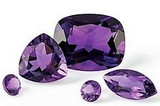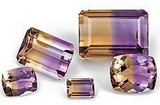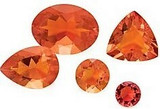What Exactly is a Faceted Calibrated Gemstone?
A faceted calibrated gemstone has been cut and polished with specific dimensions to meet standard measurements and or sizes. These gemstones are cut to specific geometric shapes, commonly round, oval, pear, octagon, marquise shapes and sizes to fit into standardized jewelry settings, such as prong settings, bezel settings, or channel settings, without the need for custom adjustments. The term "calibrated" refers to the consistent and standard measurements of these gemstones.
Standard Size: These gemstones are cut to specific dimensions and sizes, typically measured in millimeters. Common shapes include rounds, ovals, squares, and rectangles.
Standard Faceting: Faceted calibrated gemstones have a standardized type of cut, typically known as a star or mixed cut with a consistent number of facets. The facets are strategically placed to enhance the gemstone's brilliance and uniform appearance.
Uniformity: A calibrated gemstones is uniform in size and shape, making them easy to match and set in coordinated jewelry pieces like rings, pendants, and earrings.
Ease of Setting: Because these gemstones have standardized measurements, jewelers can use pre-made settings and mountings that are designed to accommodate specific sizes and shapes.
Availability: Calibrated gemstones are typically readily available in the gemstone market especially in the more common gem materials like topaz, amethyst, citrine, quartz and other less expensive gem materials and are commonly used in mass-produced jewelry.
Shop for Quality Faceted Calibrated Loose Gemstones Online
Each type of gemstone carries within it an entire history of folklore, famed healing powers and energy and quite possibly personal meaning and sentimental value. Aside from serious gemstone collectors, most people in the market for loose gemstones are planning to set the gem into a fabulous piece of jewelry. Since all of our gemstones are in standard sizes they can be easily set into whatever mounting you choose. While some people may prefer to shop for premade jewelry, others prefer to choose the exact type and cut of gemstones to imbue more meaning and personal touch into their jewelry. For example, some people choose to make jewelry for mothers using their children's birthstones. Those who understand the healing properties and meanings of each gemstone will appreciate choosing their own gemstones and designing their own custom jewelry to suit their tastes and to tap into the power of the gemstone. Buying loose gemstones and designing personalized custom jewelry pieces adds significance and uniqueness to the jewelry.
Selection of Natural Gemstones in Calibrated Sizes
Calibrated gemstones are simply gemstones that have been cut to exact standard sizes that will easily fit into manufactured mountings without having to customize the mountings. AfricaGems.com has the largest selection of natural gemstones in calibrated sizes anywhere. Nobody can compete with our selection of calibrated gems in terms of the different gem types, sizes offered, qualities offered and low price points.
AfricaGems Offers FREE Matching Service on All Orders
Want a perfect matched pair of 5x2.5mm tsavorite baguettes along with a matching 6x4mm emerald cut tsavorite? AfricaGems can do it-nobody else can! We do all the work and you can rest assured that the matching and quality of gems will be top quality. Need 25 pieces of matching 7x5 mm oval deep blue aquamarines overnighted? Yes we can do that too! Our gemstones are graded and matched by professional gem graders with years of experience.
How is a Rough Stone Turned into A Faceted Gemstone? - Best Quality Natural Gemstones in Every Shape
The shape that a gemstone will be cut largely depends on the shape of the rough stone, but one must also take the color, gemstone type as well as internal flaws into account when determining the optimal shape. Faceting, which refers to the geometrical flat surfaces covering the gemstone, brings out the utmost brilliance and shine from each gemstone; each cut along the surface of the gem is a facet. Today the facets are cut with machinery that shape and polish the gemstone.
Gemstones in All Shapes for SALE - How to Choose the Right Gemstone Shape for Jewelry
The first consideration when picking a loose gemstone shape is the piece of jewelry that you plan to set it in. For example, in choosing a gemstone to be in the center of a ring it's important to consider the woman's hand shape. While a round cut is usually flattering to all hand types, oval and marquise shape are perfect for thin or tapered fingers and thicker fingers can usually wear princess and square cut stones very well. Pear and briolette shapes are great for earrings and pendants as they tend to elongate the jewelry and flatter the neckline and jaw line.
Learn About the Different Gemstone Shapes - The Guide to Shopping for Loose Faceted Gemstones
Most Round Cut stones contain 57 facets and are cut in the brilliant style which maximizes shine and brilliance. Oval Cut gemstones have a 2:1 length to width ratio and are cut into 69 facets; well cut Oval shaped gemstones boast an amazing shimmer and fire. Emerald Cut can best be described as a rectangle with truncated corners and have 50 facets and sleek step style levels that show off colors to their fullest. The difference between Princess Cut and Square Step Cut is manifold: Princess Cut stones have 76 facets and produce a tremendous amount of sparkle and luster; Step Cut gems have 57 facets and the leveled style resembles a low pyramid without a point, they represent balance and equanimity. Pear Shape or teardrop shaped gems, combine the look of Oval Cut and Marquise Cut. With 71 facets, the color of the gemstone is vividly expressed through the Pear Cut shape. As you can see each shape has unique attributes that express the gemstone's color and brilliance in a different way.
Learn More About Calibrated Gemstones
Read The Current Issue of Gems & Gemology
























